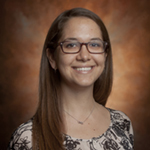Jessica Carr

Religious Studies
Q: What motivated you to apply for an IL grant for REL 306 Jewish Responses to the Holocaust?
A: In all my courses, I teach students the research process and to be critical of sources. The grant offered me the opportunity to collaborate with a librarian and to improve and expand how I teach in these two areas. “Jewish Responses to the Holocaust” is especially well suited to ask students to reflect on how we gain and organize knowledge in our everyday lives and how scholars analyze ideas and practices in the world. We examine several types of sources in the course: literature, theology, photography, film, political trials, memorials, and the representation of all these. The Holocaust is a familiar topic for Americans, but it has not always been. Therefore we try to deconstruct how it has become such a popular topic in historical study, social memory, and personal understanding. We also analyze the role of economics in memorializing the Holocaust, from tourism to film profits.
Q: How did you structure and sequence the research project?
A: Students complete a series of assignments that gradually build their final research project. Each week, students submit a one-page paper on the major points of that week’s texts. They consider not only the argument of the texts but also the evidence that scholars use to make their arguments. After a few weeks, students submit a “shelfie.” With some practice in writing, citation, and research skills, students submit a short proposal and annotated bibliography. The proposal provides us the opportunity to discuss how to conceive and organize a research topic and how to begin working on it. The annotated bibliography, along with weekly writings, allows students to begin to write what they can revise and expand upon for their final project. We hold in-class workshops for projects longer than the weekly papers so that students see each other’s work and receive feedback. Students continue to expand their annotated bibliography and workshop a draft of their final paper before submitting it at the end of the semester.
Q: A few weeks into the semester, you asked students to submit shelfies. What is a shelfie? Why did you assign it?
A: A “shelfie” is a “selfie” in the library with a book from the shelf! It is a fun way to practice research and think extensively about how we find texts for our projects. Students research a new source that complements in-class discussions and their personal interests. They post a picture of themselves with a book in the library stacks. Students learn what a call number is, and as a group we discuss several aspects of the search or “presearch” process and what makes a source “academic.”
Q: One of the main goals for this class was to help students understand that the memory about the Holocaust is historically and contextually contingent. What in-class activities did you do to help achieve this goal?
A: For me, this is where the comparative methodology of history and religious studies is so important, as is literary theory about reception. We studied both primary and secondary sources each week that gave perspectives of multiple geographic contextual responses, such as the differences between understandings and representations of the Holocaust in the US, Germany, Israel, and Poland. We also traced how the same text has been received in different times and places: this includes both the form it took and how people reacted.
Q: You worked closely with Ben Jahre on this class. What were the advantages of collaborating with a librarian?
A: It was great to have someone help me plan my syllabus and my individual assignments. Ben joined our class for discussions, and his personal and professional background gave him an ability to ask students and me to think about different questions that I could have raised on my own. It was nice to be able to debrief after seminar meetings to discuss what points had been most salient and what might be important to make clear in the future. It really helped me reflect on my teaching. For students it meant having someone they could turn to for assistance on the project who knew our class intimately and who they could ask questions with a different kind of interaction than they might expect from a professor.
Q: Would you continue to incorporate IL into future versions of this course or other courses?
A: I definitely will! Now when I begin my students on any research assignment, whether it is a shelfie or something larger, I always ask a librarian to meet with the class.
Q: What do you think professors and librarians could do to help students develop their critical thinking and IL skills?
A: It seems especially important to help students understand what we mean by an “academic source.” I’ve realized that it’s important to clarify what this means by division or discipline, although there are aspects of peer review that are common across scholarly disciplines. Lafayette students are skilled thinkers, but part of a college education should be to help students gain more specialization in understanding knowledge production and publication.
Q: Do you have any advice for faculty who are interested in integrating IL into their classes?
A: Don’t expect to have a total plan for how IL fits with your class before you meet with librarians. Part of IL is to help professors understand the expertise that librarians can offer, so librarians can help us shape what questions or projects we need to pursue through IL.